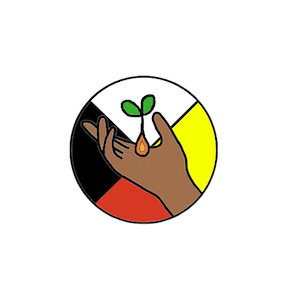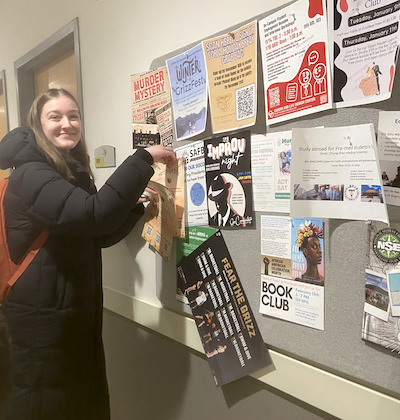‘The Place Where We All Grow’
SHS ECLIPSE students create resource hub and graphic for Oakland University's Native American Advisory Committee

In 2022, Oakland University dedicated land on its campus, called Gidinawemaaganinaanig: Endazhigiyang (All My Relations: The Place Where We All Grow), for cultural place-making where Native and Indigenous lifeways and worldviews can be celebrated and shared. Soon after, the Native American Advisory Committee (NAAC) formed as a means of determining the best ways to live out the promises of its Land Acknowledgement.
When ECLIPSE students Bianca Carnevale, Hanna Gipson, Courtney Nichol and Khalil Roy were connected with the group by their professor, Sarah Martin, for their Community Health Impact Project, they set out to help the NAAC expand their reach and impact to further the health and well-being of Indigenous people at OU and beyond.
The four senior SHS students began their journey by connecting with Megan Peiser (Choctaw Nation of Oklahoma) and Andrea Knutson, co-chairs of the NAAC. These professors taught them about the committee, their mission, the Heritage Site, food sovereignty and more. From here, the team brainstormed the best ways to spread awareness and promote outreach. With full creative control, the sky was the limit – but that didn’t mean it was easy. “We wanted to do so much,” Nichol says passionately. “We knew whatever we created could benefit the organization and community, and have a big impact.”
 |
| The NAAC graphic designed by students will provide a consistent visual for NAAC materials. |
The group eventually proposed two ideas: a graphic and a resource hub. With the NAAC’s approval and enthusiasm, the process began.
The team designed a graphic for the committee to provide a consistent visual for their materials. “The goal was to create some continuity,” Gipson explains, “so that when you see the graphic, you recognize that it is connected to the NAAC and their events.” With design led by Nichol in close collaboration with the committee, the graphic consists of a sprouting seedling being held in a human hand, with the traditional Native American medicine wheel in the background. The design is simple enough for traditional beading designs and represents the culturally-valued, healthy relationship between humans and the land. Nichol explains, “In society, we have a lot of views of land possession, but they view human’s relationship with the land as a full circle – both sides are giving.”
 |
| The resource hub is home to information such as healthy cultural recipes, types of plants and their significance, food sovereignty and event fliers. |
The group also worked closely with the committee to create a resource hub that is home to information such as healthy cultural recipes, types of plants and their significance, details about food sovereignty, fliers for the NAAC and more. The team hopes individuals seeking to get involved with the committee explore the hub so they have basic knowledge of how to be respectful of the site and culture.
Furthermore, the hub is important to the Native American community as a whole; during land dispossession, traditions that were passed down orally were lost as the Indigenous people were culturally assimilated and restricted from speaking in their native tongue, making a collection of information culturally valuable.
After a semester of cultural immersion, hard work and dedication, it was time to deliver the final presentation about the project. The stakes were high as the group faced their fellow classmates, the NAAC, Dean Kevin Ball and other health sciences faculty.
Unlike most CHIP projects, this had the possibility of having a significant long-term impact on the entire organization. But as soon as the team began their presentation, any existing anxieties were quelled. “With the room quiet as everyone listened, the NAAC celebrated our work, giving applause randomly throughout and saying things like ‘I love that part too’,” Roy enthusiastically states. Carnevale adds, “It was so rewarding to see their reactions. They were so pleased and grateful.”
The team hopes that the resource hub and graphic will promote awareness of and engagement with the committee. “The NAAC has such a valuable existence,” Carnevale says. “They have a lot of big plans for the future and hopefully our project will help elevate their progress.” Throughout the whole process, however, the team made sure to practice extensive cultural humility. “We took as much as we could from this,” Roy elaborates, “but they are a group of people practicing a certain way and we need to respect that.”
For the four students, “The Place Where We All Grow” has provided them with a tremendous learning experience. “We started without knowledge of the NAAC, and it was definitely not what we expected going into the project,” Gipson states on behalf of the group, “but it was so nice to be given the chance to grow in this way. They really took us in and taught us about their culture, and that was so special. We’re all very thankful for the opportunity.”
Discover Oakland University’s Land Acknowledgement and learn about the Native American Advisory Committee.
Visit the ECLIPSE website to learn more about the program empowering our students to impact the health of communities.


 February 22, 2024
February 22, 2024